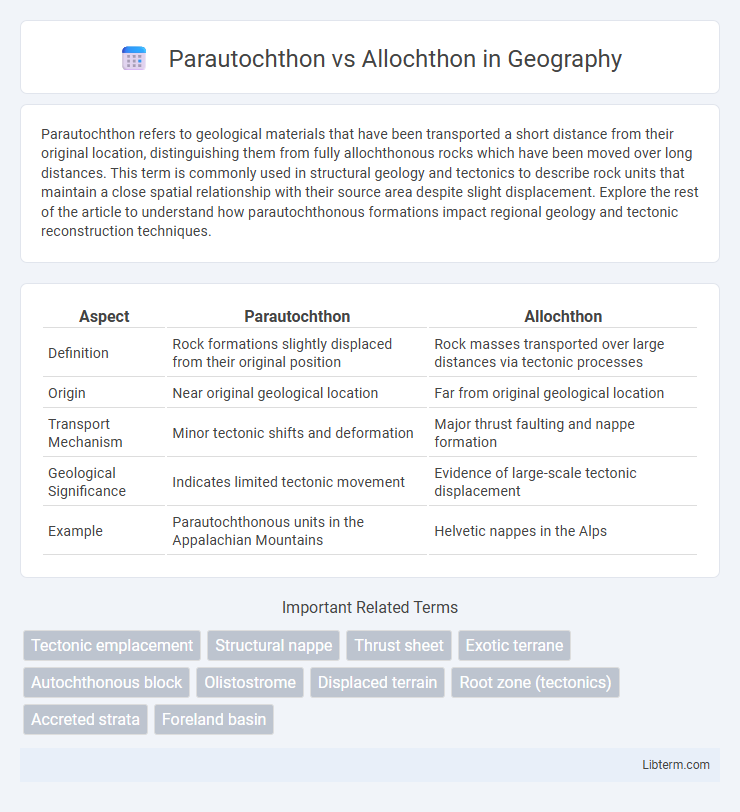Parautochthon refers to geological materials that have been transported a short distance from their original location, distinguishing them from fully allochthonous rocks which have been moved over long distances. This term is commonly used in structural geology and tectonics to describe rock units that maintain a close spatial relationship with their source area despite slight displacement. Explore the rest of the article to understand how parautochthonous formations impact regional geology and tectonic reconstruction techniques.
Table of Comparison
| Aspect | Parautochthon | Allochthon |
|---|---|---|
| Definition | Rock formations slightly displaced from their original position | Rock masses transported over large distances via tectonic processes |
| Origin | Near original geological location | Far from original geological location |
| Transport Mechanism | Minor tectonic shifts and deformation | Major thrust faulting and nappe formation |
| Geological Significance | Indicates limited tectonic movement | Evidence of large-scale tectonic displacement |
| Example | Parautochthonous units in the Appalachian Mountains | Helvetic nappes in the Alps |
Introduction to Parautochthon and Allochthon
Parautochthon refers to geological units that have been displaced from their original position but remain relatively close to their source area, often showing minimal deformation. Allochthon describes rock masses transported considerable distances from their original location, typically along large thrust faults, and frequently exhibit significant structural alteration. Understanding the distinction between parautochthonous and allochthonous units is essential for reconstructing tectonic histories and sedimentary basin evolution.
Defining Parautochthon: Geological Context
Parautochthon refers to rock units that lie close to their original position relative to the basement but have experienced slight displacement due to tectonic forces, typically within a few kilometers. These rocks usually sit above the autochthonous basement and retain much of their original stratigraphic order, distinguishing them from allochthonous units that are transported over considerable distances. In geological contexts, identifying parautochthonous formations helps in reconstructing tectonic histories, especially in fold-and-thrust belts where displacement gradients vary from minimal to extensive.
Allochthon Explained: Key Geological Features
Allochthon refers to rock masses that have been transported from their original location usually over significant distances through tectonic processes such as thrust faulting. Key geological features of allochthons include their positioning above autochthonous rocks, the presence of thrust faults or nappe structures, and often a marked distinction in lithology or age from underlying formations. Recognizing allochthons involves studying deformation patterns, metamorphic grade differences, and sedimentary sequences disrupted by tectonic movement.
Fundamental Differences Between Parautochthon and Allochthon
Parautochthon refers to rocks or geological units that are displaced only a short distance from their original position, typically along low-angle faults, maintaining much of their original stratigraphic order and relationship. Allochthon, in contrast, denotes large-scale tectonic units transported over considerable distances, often tens to hundreds of kilometers, involving complex thrust faulting and deformation that places them far from their initial location. The fundamental difference lies in the degree of displacement and deformation, where parautochthonous blocks experience minimal movement compared to the extensive transport and structural reworking characteristic of allochthonous terranes.
Tectonic Processes Shaping Parautochthon and Allochthon
Parautochthon and allochthon represent distinct tectonic units formed through different geological processes during orogenic events. Parautochthon involves rocks that have been slightly displaced from their original position, typically through low-angle thrust faulting and slight folding near plate boundaries. Allochthon involves large-scale tectonic transport of rock masses over considerable distances through high-angle thrust faults and nappes, reflecting intense compressional forces and crustal shortening in convergent plate boundaries.
Worldwide Examples of Parautochthonous Formations
Parautochthonous formations are geological units that have undergone slight displacement from their original position, typically found near their source rocks, contrasting with allochthonous units transported over large distances. Worldwide examples include the Helvetic nappes in the Swiss Alps, which display limited displacement relative to their basement, and the Moine Supergroup in Scotland, representing parautochthonous rocks involved in the Caledonian orogeny. These formations provide critical insights into tectonic processes and the mechanical behavior of Earth's crust during orogenic events.
Notable Allochthonous Geological Structures
Notable allochthonous geological structures include thrust sheets and nappe complexes that have been transported over considerable distances from their original positions, often observed in mountain belts like the Alps and the Appalachians. These structures form through large-scale tectonic processes such as continental collision and subduction, resulting in displaced rock masses that contrast with parautochthonous units, which remain close to their initial formation sites. Allochthonous formations are key to understanding regional metamorphism, tectonic evolution, and the dynamics of crustal deformation.
Methods for Identifying Parautochthon and Allochthon
Methods for identifying parautochthon and allochthon involve detailed structural, stratigraphic, and petrological analyses. Parautochthonous rocks are recognized by their proximity and slight displacement from the original position, often displaying minor deformation and preserved stratigraphic order. In contrast, allochthonous units show significant transport, intense deformation, and tectonic contacts such as thrust faults, with techniques like seismic imaging, geochronology, and paleomagnetic studies employed to distinguish these features.
Importance in Geological Mapping and Resource Exploration
Parautochthon and allochthon formations are critical in geological mapping due to their distinct tectonic origins, which influence fault identification and structural interpretation. Recognizing parautochthonous rocks, which remain near their original position, versus allochthonous rocks, displaced from their source, aids in accurate subsurface modeling and hydrocarbon exploration. This differentiation enhances resource exploration by pinpointing potential reservoirs trapped within thrust sheets and fold belts typical of allochthonous terrains.
Summary: Implications for Earth Science
Parautochthon and allochthon refer to distinct geological units with different origins and transport histories, crucial for understanding tectonic processes. Parautochthonous rocks are closely related to their original basement, experiencing minor displacement, while allochthonous units have been significantly transported, often via large-scale thrust faulting. Differentiating these units aids in reconstructing regional geodynamics, elucidating crustal deformation, and interpreting plate tectonic interactions in orogenic belts.
Parautochthon Infographic

 libterm.com
libterm.com